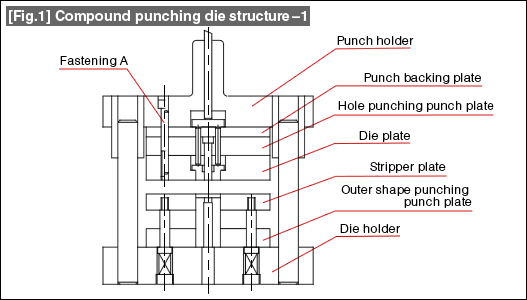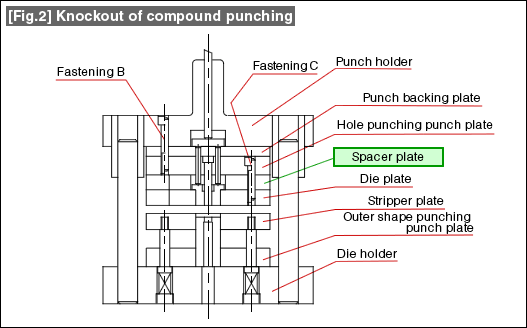#155 Design of Compound Punching Dies (4) Structure of a Compound Punching Die
The basic structure of a compound punching die is shown in Fig. 1.

The compound punching die is used for compound forming operations (outer shape punching and hole punching). The method of preparing the structure of compound forming has been explained in Tutorial No. 8 "Method of Preparing Compound Die Structures". After that, "Structure of Compound Dies" has been explained in Tutorial No. 31. Please refer to these tutorials. In this tutorial, explanations are given about further detailed items.
Depending on the die, the plate configuration that constitutes the die becomes extremely important. This is because it affects the cost of the die. The plate configuration of a compound die has seven plates (fig.1). The die plate becomes somewhat thick because it is necessary to assemble the knockout inside it. When the punch is large, sometimes the punch plate is not used but the fixing is done directly to the die holder.
| ※ | The structure of a compound die is the inverted placement structure. In the inverted placement structure, the punch is placed below and the die is placed above (for outer shape punching). Some of you may feel that there is something strange in the relationship between the punch holder and the die holder, but the holder that is attached to the slide of the press machine is taken as the punch holder, and the holder that is attached to the bolster is taken as the die holder. |
When handling small product shapes, sometimes a backing plate is also used below the punch plate for the outer shape punching by the bottom die. Eliminating the backing plate for hole punching by the top die is very rare. The materials of the respective plates are given below. Punch, die holder, and punch plate: S50C or SS400 Backing plate: SK3 to SK5 Punch, die plate: SK33 or SKD11
Fig. 2 shows a plate configuration in which the die plate is divided into two.

This is used when the underside counter boring for the knockout is cumbersome, or when it is wanted to save the material of the die plate. Although the name of the plate produced out of dividing is called here as the spacer plate, it is also called by other names such as "play plate", etc. Since this plate is for making the knockout movable, the material used is S50C or SS400. Since the number of plates becomes large in a die for compound punching, sometimes the die is prepared with some special techniques in its design. This is the method used when the die is prepared by wire cut electric discharge machining. If the die plate is prepared by wire cut electric discharge machining, although the material inside the die is cut away, this material is used as the punch. With one single plate, it is possible to prepare the punch and the die. When the plate is thin, the die is prepared using taper machining of wire cut electric discharge machining.
Similarly, at the time of preparing the stripper plate, the material that is cut away is used as the knockout. If such techniques are used, while the die material can be saved, at the same time, even the preparation of the die becomes faster. This is suitable for the production of small volumes. The number of plates becomes large in the top die of a compound punching die. Although this is a method of using bolts and dowel pins (knockouts) as was shown by "fastening A" in Fig. 1, the number of penetrating plates is large and hence one might feel that there are problems in reliability. This is more so when a spacer plate is used. As shown by "Fastening B" and "Fastening C" in Fig. 2, in some cases, the die plate and the punch plate for hole punching are integrated together, and the fastening as the top die is made separate. While the dowel pin is the component that determines the positional relationship, the reliability becomes poor as the pin becomes longer. It is considered good if the number of plates that the dowel pin penetrates is about three.
The method of fastening and the work of assembling the die are related to each other. It is necessary to select the fastening considering the fastening of plates as well as the operation of pierce punch spotting of the die.
- #167 Problems in Punching and their Countermeasures (6) Scrap Processing in Punching
- #166 Problems in Punching and their Countermeasures (5) Trimming of Drawn and Shaped Parts
- #165 Problems in Punching and their Countermeasures (4) Scrap Clogging in Punching
- #164 Problems in Punching and their Countermeasures (3) Bending and Twisting of Narrow Punched Parts
- #163 Problems in Punching and their Countermeasures (2) Bending due to Punching



